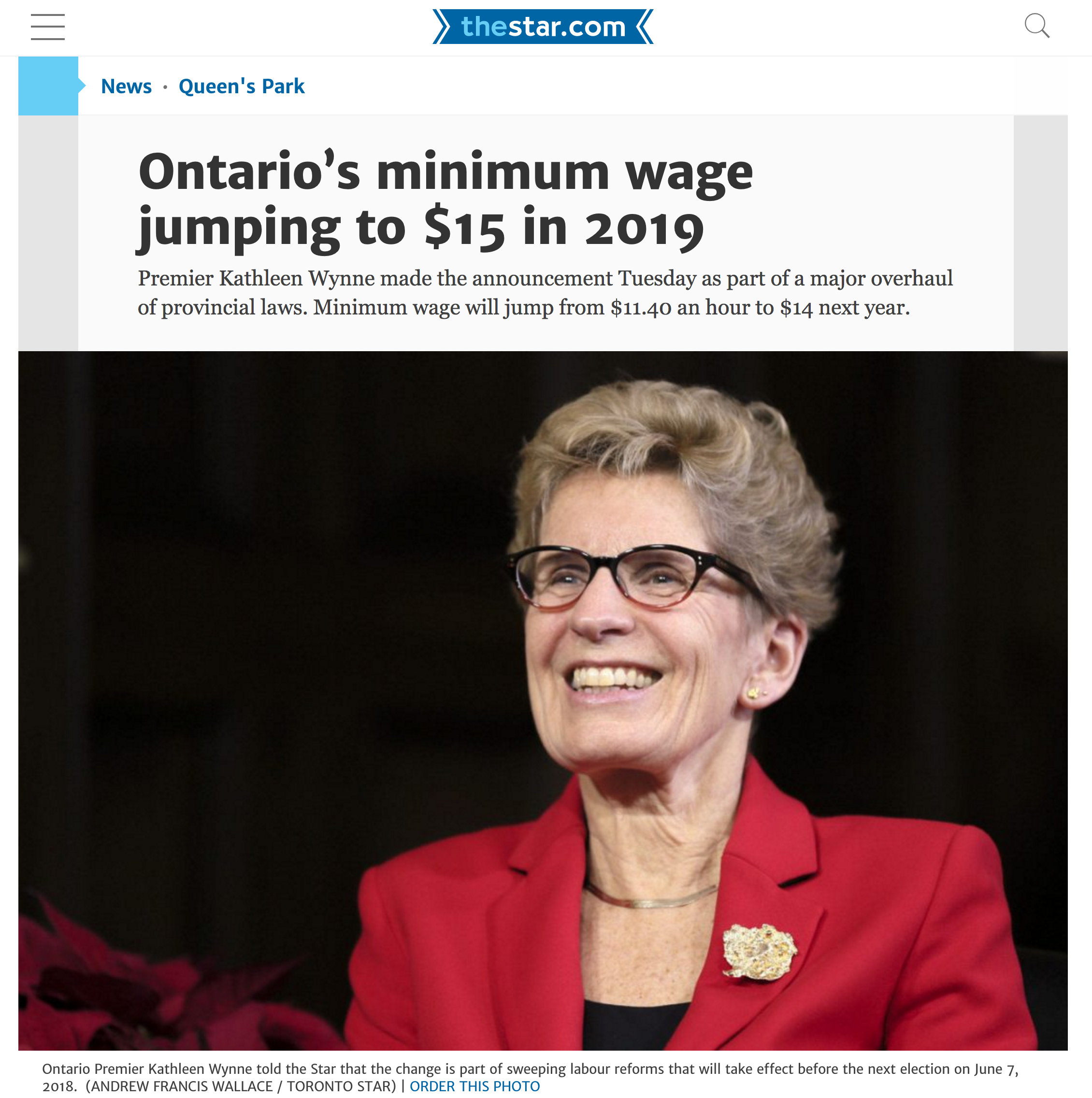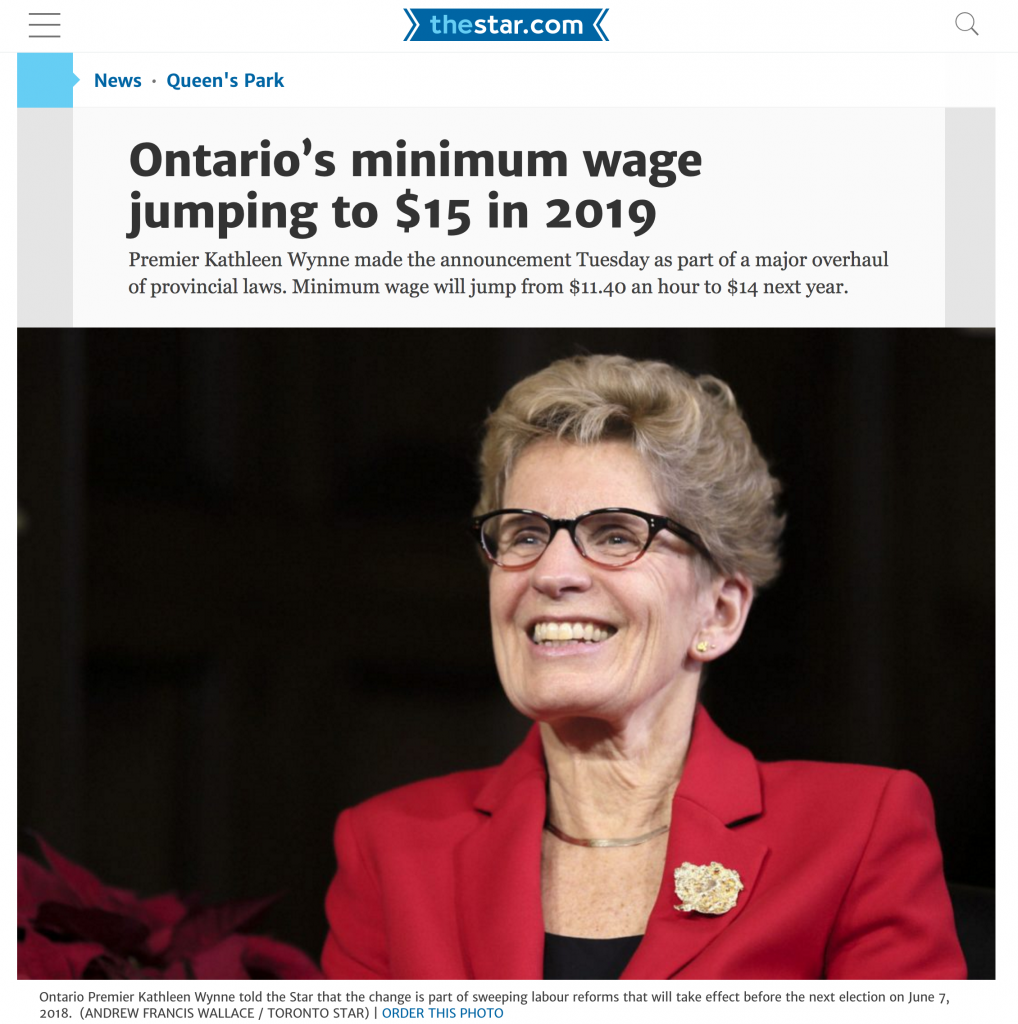Introducing Chef Jesse Vallins’ new irregular Good Food Revolution opinion column, Ham On Wry.
What Could Happen AKA My Slightly Hyperbolic but Possibly Accurate Take on What the Minimum Wage Hike Means for Restaurants
Kathleen Wynne announced the other week that the provincial minimum wage is going to increase from the current $11.40 to $15 over the next 18 months. No matter your feelings on the Premier and her party, or the theoretical motive behind the increase, this is big news for Ontarians. This isn’t really a new idea. It looks like North America-wide this will be the norm in the next five or so years, so it could be Ms. Wynne is just trying to stay ahead of the curve. Regardless of how much you feel the minimum wage should be, or if one should be entitled to a “livable” amount for frying chicken nuggets, it’s going to happen.
Other than a paper route and a couple of brief stints as a telemarketer and guitar salesman in my teens, I’ve only ever worked in hospitality. For all I know, this will affect everyone more or less equally. I’m not saying that I’m against the increase or that it’s inherently bad, but I’m saying this will cause serious waves in the restaurant industry. Right now, I see the restaurant industry as a whole as Bruce Wayne dancing with Selena Kyle in the Dark Knight Rises. She’s just given him the, “There’s a storm coming….” speech, and he’s trying to figure out exactly what it means and what needs to be done. Restaurants are going to need to change. This has been a long time coming. The ever-increasing amount of competition, rising rent, and the spike in cost of product (especially meat) are already thorns in almost every establishment’s side. The minimum wage hike is not the specific problem. It will, however, exacerbate many existing problems, and with how quickly the hike is coming, it may well be the anvil that breaks the camel’s back. What will happen? It’s hard to say exactly, but it’s pretty safe to say that restaurant prices at all levels will go up at least a little, if not significantly. It doesn’t matter the concept – from the gastronomic temple to the snack bar on the corner – if the same staff are costing restaurants 25% more than they were only recently, the lack of savings will be passed on the guest. It may not be terrible for everyone, in this relatively deceptively titled article from Forbes, Wetzel’s Pretzels in California seems to be doing great, but it’s tough to pinpoint what’s happening to everyone else.
For the most part, the high end will survive. They’re already expensive and the increase in their prices won’t seem as severe in comparison. Whether from just being able to afford it or from saving up, people also tend to go to these places as destinations or for celebrating with the knowledge of the money they’re going to spend. They may not all survive, but this will separate the proverbial men from the boys of the genre. The low end and fast food will get creative. They’ll make use of even cheaper product and embrace technology to do more with fewer hands. More automation and less human interaction, “Would you like fries with that?” becoming a prompt you respond to with the tap of a screen or push of a button, rather than a spoken yes or no. But no one really goes to these places for human interaction, anyway.
We will, unfortunately, most likely see the mid-range start to disappear – the neighbourhood wine bar, the bistro serving simple food, the talented young chef doing small and more affordable tasting menus to say what they want to tell the world through his or her food – This is the segment who will be hit the hardest. This is because they generally need to employ the same level of staff, and buy similar product as the high end establishments, then try to operate on a lower price point hoping to make up the difference in volume. Though this will affect all levels, the mid-range especially will be forced to attempt to produce the same product/experience with less staff while also having to raise prices. And this is impossible. It’s like trying to put all the groceries in one bag, but then not having to deal with the bag being heavier than it was before. Chain restaurants, the cockroaches of the restaurant world, have the capital to pay big rents, save money by purchasing in bulk across several locations, and have simplified their operations to a science to employ a revolving door of unskilled labour. They’ll be able to absorb the higher labour costs, and once stand-alone restaurants start closing, will multiply like rabbits. Then they’ll parade around their respective takes on a burger with cheese & crispy onion straws, pasta with grilled shrimp in cream sauce, and chicken caesar wraps to the world as if they’ve created fire. Normals everywhere will literally eat it up.
Is this the end of the world? It might depend on if you see the glass as half full or half empty. Maybe restaurants won’t be able to cope with the increased costs and will be forced to close, or maybe the increase in minimum wage will make restaurants busier due to more money in more people’s pockets and things will even out? Maybe a little bit of both will happen? But maybe we’re looking at the glass conundrum the wrong way. Maybe instead of full or empty, we should be looking at the glass as twice as big as it needs to be. I think one of the biggest changes we could see is the stripping away of what might be considered unnecessary, leaving the focus on the food. Tablecloths, fine china, crystal glassware, and exhaustive wine programs are all wonderful things, but have already seen a steady decline over the last decade, and while I don’t think these will ever disappear entirely, are they integral to making good food? No. They are the rims and leather interior of the vehicle, not the wheels or the engine. They might make your trip from point A to point B more enjoyable, but you can still drive the car without them. Whether this is a good thing or a bad thing depends on your point of view, but if those sorts of costs that a restaurant usually has to deal with are taken out of the overhead equation, it frees up capital to be spent elsewhere. Maybe we’ll see the increase in higher quality QSR options with serious chefs behind them, like Superiority Burger or Made Nice in New York. We may see more chefs striking out on their own and starting up intimate, dinner party style restaurants, like 42 grams or schwa in Chicago. Or maybe it’ll end up like Demolition Man, and all restaurants will become Taco Bell. [I seriously hope not! – JD]
According to Eckard Tolle, in an ever changing world, a species needs to adapt or they will die out. He says “Restaurants are now faced with this stark choice to either adapt or die.”
He actually said humans and not restaurants, but it might just be our turn first.
 Scarborough native Jesse Vallins is the executive chef at Maple Leaf Tavern and Port Restaurant, and a co-founder and partner at Merit Brewing Co in Hamilton. He’s spent the last two decades cooking in some of the Toronto’s best restaurants. His passion for the industry has led to in-depth study in all aspects of the restaurant world, as well as stages in top restaurants both in Toronto and internationally. When he’s not working in his restaurants, Jesse teaches and develops curriculum at Toronto’s George Brown College, and contributes content to online publications like Serious Eats, and, of course, Good Food Revolution
Scarborough native Jesse Vallins is the executive chef at Maple Leaf Tavern and Port Restaurant, and a co-founder and partner at Merit Brewing Co in Hamilton. He’s spent the last two decades cooking in some of the Toronto’s best restaurants. His passion for the industry has led to in-depth study in all aspects of the restaurant world, as well as stages in top restaurants both in Toronto and internationally. When he’s not working in his restaurants, Jesse teaches and develops curriculum at Toronto’s George Brown College, and contributes content to online publications like Serious Eats, and, of course, Good Food Revolution








